
| Teach Yourself Card Counting At Blackjack |
| Is this 'Just Another Blackjack Site'? No way! Every blackjack player should know how to play Basic Strategy, but what about Card Counting? At this site you will discover that card counting flows quite naturally from basic strategy. This knocks on the head a fairly common idea among players that they are separate worlds. A unique display shows you their very close relationship. The display also enables you to teach yourself card counting at your own pace. You will discover that it is much easier than you ever imagined and it's all for free. |

Gamblers make errors because they only guess at how to play each new hand as it comes along. There are such a large number of decisions that many of their guesses are bound to be wrong. Learning to play takes only a couple of minutes, but learning to win takes time and effort. If you want to win you will have to learn to 'count the cards'. Most blackjack players have heard of card counting and although they don't know how it is done, they tend to believe it is a way to win. Despite this belief and their own growing losses, they make little effort to find out the least thing about card counting. With this attitude is it any wonder that most players lose?
Players, unaware of their own faults, blame other players for their losses. They say that bad players at the table caused them to lose. They are right up to a point except that they fail to realize that THEY were those bad players and that they had caused themselves to lose. Card counters join into games with bad players at the table and still win. If bad players could cause good players to lose, how could that happen? Card counters don't believe other players have any effect on the game at all but the gamblers do.
Players offer advice and share their opinions of the game with other players. Much of what they say is wrong which leads to most players playing a similar losing game. They regard anyone who doesn't play their way to be a bad player. But why? They are just a bunch of losers. If you want to win you will have to play some of the hands the opposite way to how they play them. Ignore all opinions, including your own, of everything about the game until you have checked it out.
top
Even for the player who will never be a card counter, basic strategy is the best strategy he can use. It is not a winning strategy but it loses less than any other non-counting strategy. Basic strategy loses about 0.5% (half of one percent). This is far better than the guess-work strategies of ordinary players which lose between 1% and 6%.
A reasonable question you might ask is this: "Basic strategy might be the best strategy but what is the point of playing it if it loses?" Answer: "There is no point if that's as far as you go. All it would do is slow down your loss rate and take longer for you to go broke." You might even consider its low loss rate as a fair price to pay for entertainment. However, if you want to win you will need a good foundation for your card counting game and basic strategy forms that foundation.
If you play basic strategy it is very likely that you will be one of the better players in the casino. That doesn't just mean some particular casino but any casino you happen to be playing anywhere in the world. And being one of the best players includes all of the other casino games, not just blackjack. The reason for this bold statement is because the winning edge the casino has over a basic strategy player is less than for any other game.
top
| Playing Action | Opposite Playing Action | |
|---|---|---|
| Take a Card | Don't Take a Card (Stay) | |
| Split a Pair | Don't Split a Pair | |
| Double Down | Don't Double Down | |
| Take Insurance | Don't Take Insurance |
Basic Strategy arose from this simple idea: Test a hand to see whether the Playing Action or the Opposite Playing Action is the best way to play the hand. Do this for every hand. Group all of the best plays into a strategy and call it Basic Strategy.
Basic strategy shows exactly how every hand is played. It only takes into account the dealer's card and the cards in your own hand. It is very important to understand that despite what cards have already been dealt, basic strategy always considers the remaining cards in the pack to consist of one full 52 card deck. For any given hand, basic strategy does not indicate that the play it recommends is likely to win or lose that hand. However, in the long run it will win more on the good hands and lose less on the bad hands than any other strategy. It is the best way to play whatever hand you happen to be dealt.
top

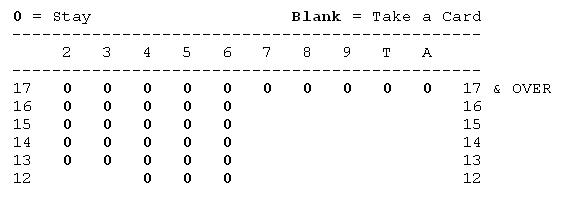

Switch to Hi-Lo Hard Double Down

Switch to Hi-Lo Soft Double Down

Basic strategy is the best way to play if you are not counting cards. Unfortunately, it is not a winning play. It is just too crude for the purpose. Every hand offers you the choice of only two ways to play. Either it is this way or it is the opposite way. Basic strategy will recommend one of the ways and a basic strategy player will always play that way. The thought may cross your mind that because basic strategy is based on a full deck then it may not always remain the best once some cards have been dealt. Because basic strategy does not adjust to the changing pattern of cards it is a losing strategy. Because you want to win you must sometimes play hands the other way. In other words, the reverse of basic strategy. Note that it says 'sometimes'. Much of the time a hand should be played as basic strategy, but sometimes the best play for that same hand is the reverse of basic strategy. How do you decide which way to play at the time? That is what card counting does for you.
top
In the real game things are a bit more complicated than this example hand because of the rest of the cards in the pack. Fortunately, the hard work has been done for us. The reversal points for all hands have already been worked out. If basic strategy is changed in a few places to include the reversal points, the result is a card counting strategy.
Is card counting difficult to learn? Those who know nothing about it think it is! They say it's incredibly difficult, almost impossible, and it takes extraordinary skill and an exceptional memory, but how would they know? It is not nearly so difficult. Quite a lot of a card counting strategy is basic strategy, pure and simple. In fact, a basic strategy player will already know a very important aspect of card counting without even realizing it! Consider this: If a basic strategy player sees someone play a hand contrary to basic strategy he instantly recognizes the difference. The rather obvious point that comes out of this, is that a basic strategy player not only knows basic strategy but at the same time he knows reverse basic strategy. He doesn't have to learn how to reverse it, he only has to ensure he never plays with reverse basic strategy. A card counter also plays a hand with basic strategy unless the 'count' indicates to him to deliberately play it with reverse basic strategy. A basic strategy player only needs to learn the counting method to do the same.
top
Counting When Playing uses the same method as described in Counting Practice. Sometimes it is counting one card at a time and sometimes it is two cards at a time.
top
If the running count is +8 when only 2 decks happen to remain in the shoe this means that the extra cards are spread so that they average 4 per deck. A count of +8 when 4 decks remain would have an average of 2 per deck, and +8 when only 1 deck remains would have an average of 8 per deck.
This average per deck figure is called the true count because it indicates the true spread of good cards regardless of how many cards remain in the shoe. To find how many decks are still in the shoe: Estimate how many decks are stacked up in the 'used' card docker. Allow a bit extra for any cards in play on the table. Deduct this total from the full pack and this will be the number of decks in the shoe.

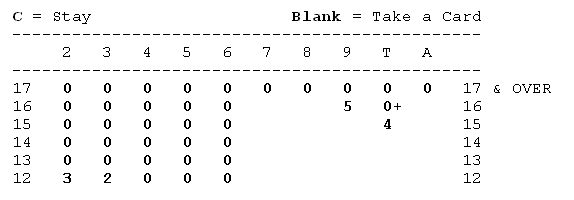

Switch to Basic Hard Double Down
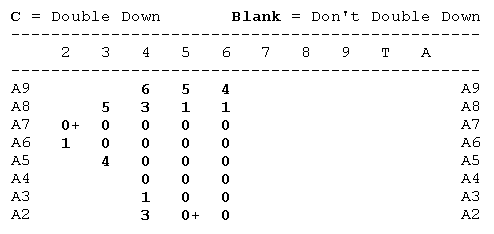
Switch to Basic Soft Double Down
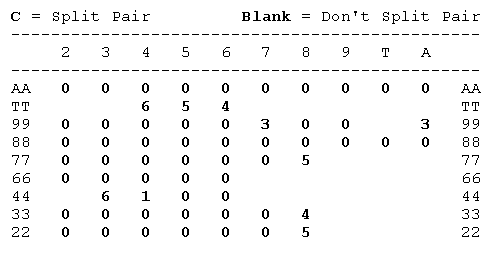
You will recall that the basic strategy charts use a symbol to indicate the playing action. The symbol could be any shape, but the symbol chosen for this presentation is a zero ( 0 ). Where there is no symbol there is a blank space to indicate the opposite playing action.
Basic strategy used 0 purely as a symbol. This particular presentation of Hi-Lo has the same symbol but changes its usage. Hi-Lo causes the symbol 0 to be transformed into a card count = 0. Although 0s usage is changed this identical appearance enables an easy transition from thinking as a basic strategy player to thinking as a card counter. A basic strategy player should have little difficulty playing any hand when the count is 0 because that is what he has been playing without even realizing it.
When the count is 0+ through 6, the changes in strategy can be seen by switching the linked charts. Note the top left of each chart: Basic Strategy shows a 0 symbol but the Hi-Lo Strategy replaces this with a C (for Count).
top
For example: Say your bankroll is $3000. Dividing your bankroll by 300 gives a Bet Unit of $10. During the game you have a count of True 5 so your bet is 4 Bet Units ($40).
This level of betting has a high degree of safety. If you want to bet a bigger Bet Unit, divide your bankroll by a number in the range 250-300 (don't go less than 250). A player who bets heavier risks losing his entire bankroll. It can be proven that a player who over-bets more than twice the optimum can lose even though he is playing an advantage game.
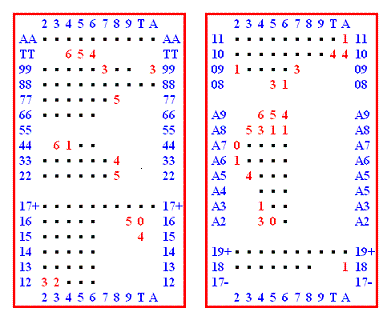
Always carry a Strategy Card when you play. One about the size of a business card similar to this color-coded example. The card is your back-up. Don't rely on your memory only. If you want to check the correct play for a hand, take the card from your pocket and have a look at it. You will only need to check the plays you can't remember. You will gradually learn these plays until you know them all. Basic strategy players please note: Whiteout the red numbers and you have a basic strategy card.
Play the smallest minimum table that will still permit your biggest bet. You will lose less while you are waiting for the count to turn 'good'. Carry plenty of cash of have an ATM or other back-up. Carry spare high value chips out of sight. Don't leave all of your chips on the table, especially if you are winning.
Play box 7 as this gives the most time to check the accuracy of your play until you get experienced. Once you have got used to counting, play box 1 or box 7. From either end of the table you see the cards in a narrow band which is the easiest layout for counting. Importantly, this cuts down on eye movements and make you less detectable as a card counter.
You must give some thought to concealing your card counting activities. If the casino suspect you are a card counter, they can tape your play and check it to see if you played on the 'count'. Never taking your eyes off the cards is bad! You must not concentrate too intensely. You will recall that in every round of play the dealer's card is the first card you count. This means that there is no need to look at the first card dealt to each player. While these cards are being dealt you can do things to deflect the casino. Talk to the dealer or a player; look for the drinks waitress; comment on the keno numbers. Imagine it being said of you, "He's not a card counter. He's not even looking at the cards."
Any time you spot a new mistake or odd event make a note on the back of a Keno ticket immediately while the details are still fresh in your mind. Keep a file of these notes at home and study each one. Try to find the best strategies for you to use in each case.
top